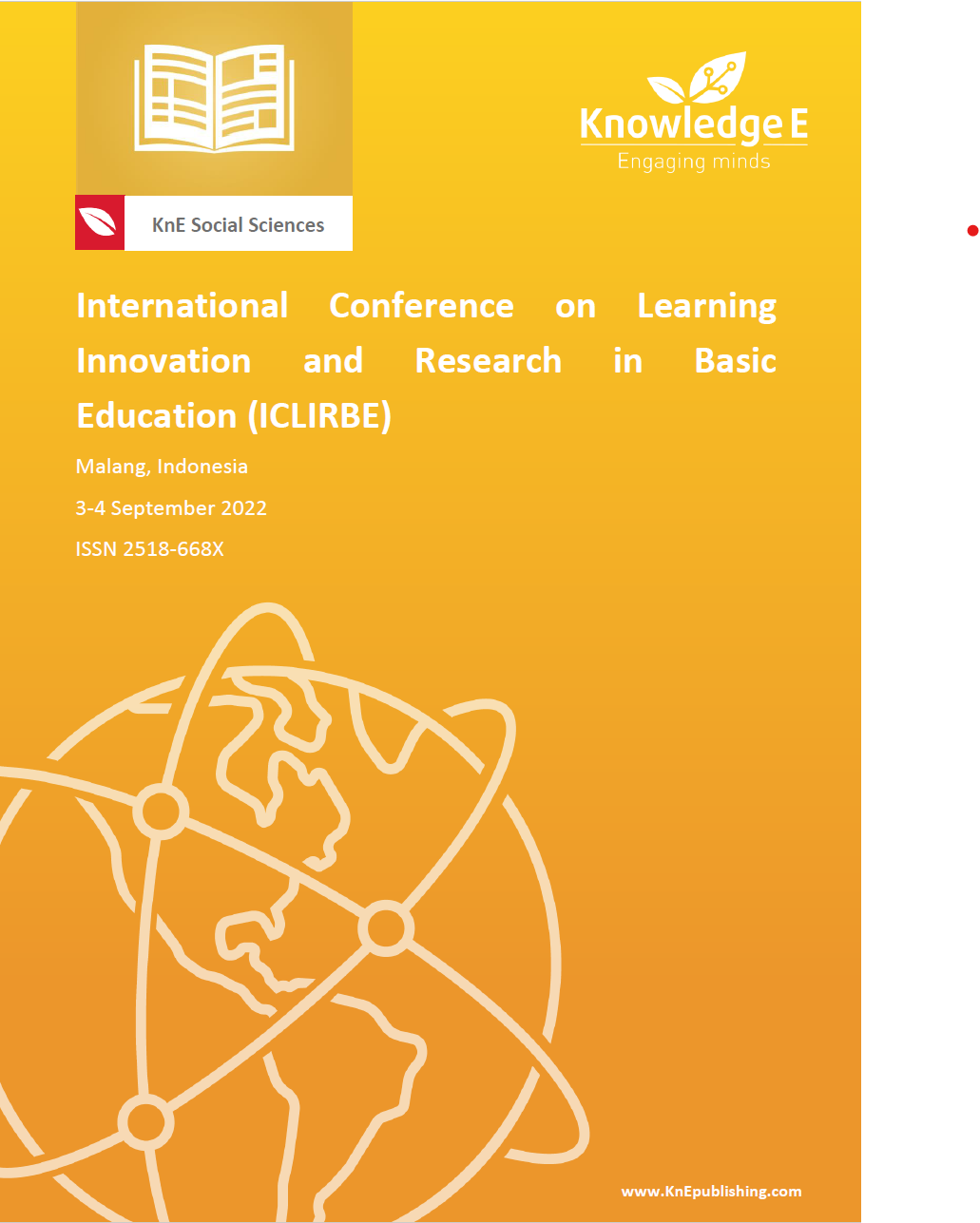Digital Literacy Analysis of Primary School Students
DOI:
https://doi.org/10.18502/kss.v8i8.13280Abstract
Digital Literacy plays an important role from contributing to education to giving birth to a generation that is ready and can contribute to the times. The study aims is to describe the situation and condition of students’ digital literacy in the city of Palembang. This is a qualitative type of research with a survey technique. Data were collected through field observations, student questionnaires and interviews, using the Miles and Huberman model data analysis techniques including: (1) data display, (2) reduction, (3) conclusion drawing, and (4) data verification. Based on the results of the study, it showed that students’ digital literacy from the critical thinking aspect (the ability to analyze and think critically in using digital technology) reached 83%, in the E-safety aspect (able to maintain security when using digital technology) reached 58%, in the digital cultural component (have the ability to communicate and contribute through digital technology media) reaching 58%, in the collaboration and creativity component (the ability to collaborate and be imaginative in using digital technology media) reaching 55%, in the find information component (the ability to select good or bad information), good reached 73.3%, in the communication component (the ability to communicate and also socialize through digital technology media) reached 63.3%, and in the functional and skill component (students are able to operate digital technology media according to their needs and functions) reached 76 %. Based on observations, it shows that the cultivation of digital literacy has been carried out in learning with the support of adequate facilities and infrastructure such as the availability of internet access, computers, projectors, and several digital teaching aids and other facilities and infrastructure.
Keywords: Digital Literacy, Primary School, Qualitative Research
References
[2] Reichert F, Lange D, Chow L. “Educational beliefs matter for classroom instruction: A comparative analysis of teachers’ beliefs about the aims of civic education.” Teach Teach Educ. 2020;98:1–13. doi:10.1016/j.tate.2020.103248
[3] Roick J, Ringeisen T. “Students’ math performance in higher education: Examining the role of self-regulated learning and self-efficacy.” Learn Individual Differs. 2018;65:148–158.
[4] Ocak G, Yamaç A. “Examination of the relationships between fifth graders’ selfregulated learning strategies, motivational beliefs, attitudes, and achievement.” Educ Sci Theory Pract. 2013;13(1):380–387.
[5] Li S, Zheng J. “The relationship between self-efficacy and self-regulated learning in one-to-one computing environment: The mediated role of task values.” Asia-Pacific Educ Res. 2018;27(6):455–463. doi:10.1007/s40299-018-0405-2
[6] Zimmerman BJ, Moylan AR. “Self-regulation: Where metacognition and motivation intersect.” In: Hacker DJ, Dunlosky J, Graesser AC, editors. Handbook of metacognition in education; 2009. p. 299–315.
[7] Pintrich PR, Smith DAF, Duncan T, Mceachie W. A manual for the use of the motivated strategies for learning questionnaire (MSLQ). Ann Arbor, Michigan; 1991.
[8] Pressley M, McCormick CB. Advanced educational psychology for educators, researchers, and policymakers. New York, USA: HarperCollins College Publishers, 1995.
[9] Bandura A. Prentice-hall series in social learning theory. Social foundations of thought and action: A social cognitive theory. Prentice-Hall, Inc., 1985.
[10] Dent AL, Koenka AC. “The relation between self-regulated learning and academic achievement across childhood and adolescence: A meta-analysis.” Educ Psychol Rev. 2015;28(3):425–474. doi:10.1007/s10648-015-9320-8
[11] Cleary TJ, Kitsantas A. “Motivation and self-regulated learning influences on middle school mathematics achievement.” School Psych Rev. 2017;46(1):88–107.
[12] Pintrich PR. “Chapter 14 - The role of goal orientation in self-regulated learning.” In: Boekaerts M, Pintrich P, Zeidner M, editors. Handbook of self-regulation. San Diego, California: Academic Press; 2000. p. 451–502.
[13] Vonkova H, Hrabak J. “The (in) comparability of ICT knowledge and skill self-assessments among upper secondary school students: The use of the anchoring vignette method.” Comput Educ. 2015;85:191–202. doi: 10.1016/j.compedu.2015.03.003.
[14] Baier F, Decker A-T, Voss T, Kleickmann T, Klusmann U, Kunter M. “What makes a good teacher? The relative importance of mathematics teachers’ cognitive ability, personality, knowledge, beliefs, and motivation for instructional quality.” Br J Educ Psychol. 2019;89(4):767–786. doi:10.1111/bjep.12256
[15] Flanagan AM, Cormier DC, Bulut O. “Achievement may be rooted in teacher expectations: Examining the differential influences of ethnicity, years of teaching, and classroom behaviour.” Soc Psychol Educ. 2020;23:1429–1448. doi: 10.1007/s11218- 020-09590-y
[16] van der Kleij FM. “Comparison of teacher and student perceptions of formative assessment feedback practices and association with individual student characteristics.” Teach Teach Educ. 2019;85(1):175–189.
[17] Brockett RG, Hiemstra R. Self-direction in adult learning: Perspectives on theory, research, and practice. London and New York: Routledge; 2020.
[18] Hiemstra R, Brockett RG. “Reframing the meaning of self-directed learning: An updated modeltt.” Adult Education Research Conference Proceedings; 2012. p. 155– 161.
[19] Geng S, Law KMY, Niu B. “Investigating self-directed learning and technology readiness in blending learning environments.” Int J Educ Technol High Educ. 2019;16(17):1–22. doi:10.1186/s41239-019-0147-0.
[20] Fraenkel JR, Wallen NE, Hyun HH. How to design and evaluate research in education. New York, USA: McGraw-Hill; 2012.
[21] Honey M, Marshall D. “The impact of on-line muti-choice questions on undergraduate student nurses’ learning.” In Proceedings of the 20th Annual Conference of the Australasian Society for Computers in Learning in Tertiary Education (ASCILITE); 2003, p. 236–243.
[22] Krueger RA, Casey MA. Focus groups: A practical guide for applied research. London: Sage Publications, Inc.; 2015.
[23] Creswell JW, Clark VLP. “Choosing a mixed methods design.” In Designing and Conducting Mixed Methods Research. California: Sage Publications, Inc.; 2011, p. 53–106.
[24] Mahvelati EH. “Learners’ perceptions and performance under peer versus teacher corrective feedback conditions.” Stud Educ Eval. 2021;70. doi:10.1016/j.stueduc.2021.100995
[25] Ismayilova K, Klassen RM. “Research and teaching self-efficacy of university faculty: Relations with job satisfaction.” Int J Educ Res. 2019;98:55–66. doi:10.1016/j.ijer.2019.08.012

